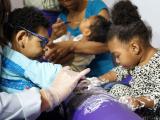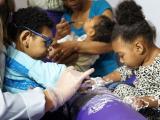Health officials from Texas and the Centers for Disease Control and Prevention (CDC) today published the first reported sexual transmission of Zika virus involving a gay male couple, a day after French clinicians detailed an instance of sexual transmission in a heterosexual pair.
The Texas case appears to be consistent with sexual transmission reported by Dallas County officials in early February, which raised the possibility that sexual spread of the virus may occur more commonly than thought and led to revised guidance for protecting pregnant women.
When the CDC revised its Zika guidance for childbearing-age women and sexual transmission in late March, it said for the first time that its recommendations also apply to men and their male sex partners. Though most of the concern with Zika virus revolves around birth defects, the virus has also been associated with neurologic conditions, including Guillain-Barre syndrome (GBS), which occurs rarely and can be triggered by different types of infections.
Both cases show the risk of virus transmission in people who traveled to affected areas and shed light on virus persistence in body fluids. Researchers published the male-to-male sexual transmission report in Morbidity and Mortality Weekly Report, and the French authors described their case in a letter to the New England Journal of Medicine (NEJM).
Male-to-male transmission risk
In the Texas case, the first patient got sick in January, 2 days after returning from a 1-week stay in Venezuela. The day before and after symptom onset he had condomless insertive anal sex with his male partner.
A few days later, his partner, who had not recently traveled outside the country, reported fever and other symptoms, followed by a rash, joint pain, and conjunctivitis. He visited his health provider, who suspected Zika virus infection and obtained a blood sample. Three days later the doctor obtained blood samples from both the patient and his partner, and 10 days later the provider collected semen, urine, and saliva specimens from both men.
Polymerase chain reaction (PCR) tests were negative for both patients, but sera from the two were positive on immunoglobulin M (IgM) testing for Zika and dengue virus, but not chikungunya. Plaque-reduction neutralization tests suggested that the first patient had been infected with Zika virus, dengue, or both, but that his partner had been infected only with Zika virus.
Urine and saliva specimens were negative on PCR testing, and semen testing with the same method was equivocal for the first patient and negative for his partner.
Dallas officials set out mosquito traps around the patients' homes to assess possible Aedes mosquito activity, even though weather conditions at the time didn't support overwintering. They found only Culex mosquitoes.
The authors said reports of sexual transmission from areas where Zika isn't circulating offer a unique chance to learn more about the transmission mode and serve as a reminder for clinicians to be vigilant for Zika infection, even in symptomatic patients who don't have a history of travel to affected areas but had unprotected sex with a traveler who did.
Possibility of oral sex involvement
The French sexual transmission case appears to be the one announced by the country's health ministry in late February. In yesterday's NEJM report, researchers said a 24-year-old woman, who had never traveled to a Zika-affected country, started having symptoms on Feb 20, seeking medical care 3 days later.
The woman reported that she had sex seven times between Feb 11 and Feb 20 with a 46-year-old man who had been in Brazil from Dec 11, 2015, through Feb 9, 2016. They had vaginal sex without ejaculation or condom use and oral sex with ejaculation. The man's Zika-like symptoms began a few days before he returned to France, which resolved the day he arrived.
Tests done at the woman's initial doctor's appointment revealed positive PCR findings on urine and saliva samples, negative PCR findings on a blood samples, and positive results on Zika antibody testing. A vaginal swab obtained about a week later was negative for Zika on PCR testing.
The man's urine sample on day 16 after illness onset was positive for Zika RNA on PCR testing, but serum and saliva samples were negative. Follow-up urine testing at day 24 was positive for Zika RNA. Semen samples were positive for Zika virus on days 18 and 24, with the virus isolated by culture of the samples from both days.
Gene sequencing of Zika virus from both patients also supported sexual transmission, though the authors said they couldn't rule out the possibility of transmission through other body fluids, such as pre-ejaculate or saliva exchanged through deep kissing. They said questions still surround how long men returning from affected areas should wear condoms, adding that guidance should address the possibility of oral transmission of the virus through semen.
Other developments
- In its weekly Zika virus situation update today, the World Health Organization (WHO) said that, based on a growing body of evidence, there is scientific consensus that Zika virus is also a cause other central nervous system fetal malformations. Last week the WHO said there was a scientific consensus that Zika is a cause of microcephaly and GBS. It also said, since its last report, St. Lucia and Belize are the latest countries to report local Zika transmission. The geographic distribution of Zika virus continues to expand in the Americas, but the number of countries reporting nontravel-linked microcephaly cases remained at six, with the number reporting Zika-associated GBS cases staying at 13.
- The US Agency for International Development (USAID) yesterday announced a $30 million grand challenge to encourage people to submit new ideas to enhance the response to the Zika outbreak and better prepare for other global disease threats. In a press release, USAID said it is specifically looking for short- and long-term solutions for vector control, personal and household protection, surveillance, diagnostics, and community engagement. It said it will start taking applications Apr 29, with Zika-linked ones due by May 20 and others due by Jun 27. The relief agency conducted a similar grand challenge during the Ebola outbreak.
- In its weekly update, Brazil's health ministry yesterday reported 109 more suspected microcephaly cases, lifting the number under investigation to 3,846, according to a statement translated and posted by Avian Flu Diary, an infectious disease news message board. The number of new suspected cases has slowed over the past few weeks. Officials confirmed 67 more cases and ruled out 252 of the earlier suspected cases, putting the total of confirmed cases at 1,113.
See also:
Apr 15 MMWR report
Feb 2 CIDRAP News story "Sexual transmission of Zika confirmed in Texas"
Apr 13 NEJM report
Feb 29 CIDRAP News story "France reports Zika sexual spread; Honduras probes GBS in pregnancy"




















